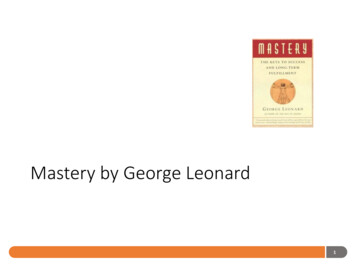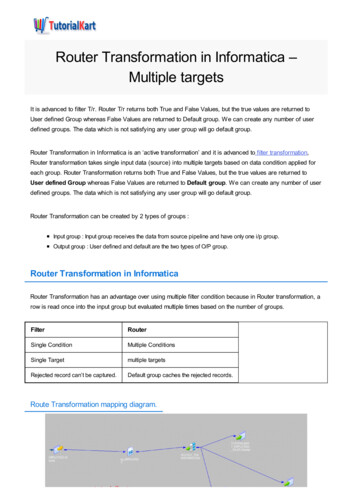
Transcription
1
The Rookie’s Guide to Options:The Beginner’s Handbook of Trading Equity OptionsBy Mark D. WolfingerIntroductory e-book versionWith a short excerpt from each chapter2
2008 by Mark D. WolfingerDownload a free copy here: http://www.mdwoptions.com/freebook.pdfW&A Publishing, Cedar Falls IowaIf you want to share this book, feel free to post it on your blog or web site.You may e-mail a copy to anyone.3
A sampling of unsolicited comments from readers: The Rookie’s Guide to Options:“Fabulous”Kim, Canada“Finally! A well done and thorough book covering what one must know to tradeand why. Kudos, Kudos, Kudos!!! No B.S. and hype to sift through. Just seriousguidance. I am very thankful you wrote it” Don, Georgia“I am thoroughly enjoying reading your new Rookies Guide To Options. I really likehow you articulate the terms contained within it. You are very clear.” Norman“I got your book last week and it is great. So far I'm in chapter 6 and it's better thanany other book about the subject. Most of the others are either too vague inexplaining options and make it sound like you cannot lose money and promise toomuch.” JP4
Buy the hard cover book from the publisher and use code:3WMWRG, to receive a 15% discount.The book is also available from Amazon.com, or you can order itfrom your favorite bookstore. Retail: 34.95.5
Table of ContentsIntroductionPart 1: Option EssentialsChapter 1: Option BasicsChapter 2: Exchange-Traded OptionsChapter 3: Why Buy or Sell an OptionChapter 4: Mechanics of TradingChapter 5: The OCCChapter 6: What is an Option Worth?Chapter 7: VolatilityChapter 8: Risk ManagementPart II: The Basic Conservative StrategiesChapter 9: The Basic Conservative StrategiesChapter 10: Covered Call Writing: Preparing to TradeChapter 11: Covered Call Writing: Making the TradeChapter 12: Covered Call Writing: After the TradeChapter 13: Collars: The Ultimate Portfolio Insurance PolicyChapter 14: Writing Cash-Secured PutsChapter 15: Equivalent Positions6
Table of ContentsPart III: Beyond the BasicsChapter 16: The GreeksChapter 17: European-Style Index OptionsChapter 18: Credit SpreadsChapter 19: Iron CondorsChapter 20: Advanced Risk ManagementChapter 21: Double DiagonalsAfterwordQuiz AnswersGlossaryIndex7
IntroductionYou are about to enter the world of options. My goal is to make your learning experience enjoyable.That means being certain you come away with a clear understanding of options - how they work andhow you can make money by incorporating option strategies into your investment methods. You willlearn to make money and reduce investment risk. In keeping with the goal of making this a funlearning experience, nothing more complicated than simple arithmetic is used.In the sports world, a rookie is someone in his or her first year of professional play. The term alsorefers to someone who is new to a profession. This book was written for newcomers to the world ofoptions - not necessarily investment rookies, but option rookies. It contains substantial backgroundinformation on options and detailed descriptions of six options strategies. These are not the onlyoption strategies available, but they were chosen because they make it easy for you to enter theworld of options. And these strategies were not chosen at random - I use only these strategies formy personal trading.8
This book is unlike any other you may have read. I don’t just tell you about a strategy and thenleave you to your own devices. I show you how to analyze alternatives and explain why each maybe appropriate for a specific investor with specific investment objectives. I teach you to think foryourselves. When you face a choice, you’ll have a basis for making a decision that’s suitable for youand your investment philosophy. It’s important that you find trades that place you within yourcomfort zone - and that means being satisfied with both the risk and potential reward of yourinvestments.Options offer substantial rewards, but not without risk. It’s true that you will have less risk that thetraditional buy and hold investor who owns stocks and mutual funds, but there’s no reason whyrisk should not be reduced further. One major goal of this book is to make you aware of theimportance of managing risk.Although this book is intended for option rookies, there’s enough material for the investor whoalready has option trading experience. When you re-read these pages to reinforce your optionseducation, you will discover that some of this material is easier to understand the second timearound. This book will be useful for many years to come.To learn to use the option markets to make money, we must begin at the beginning. That requiresan explanation of what an option is and how an option works - both in our everyday lives and in thestock market.9
Chapter One (excerpt)Option BasicsOur discussion is limited to options involving stock market investments. Thoseinclude options on individual stocks, stock indexes and some exchange tradedfunds (ETFs). Many other options exist, such as options on commodities andcurrencies. Once you understand how stock options work, you’ll alsounderstand the principles concerning other types of options.The stock options discussed here should not be confused with employee stockoptions. Those are given to the employees of some companies as part of theircompensation packages. Employee stock options are similar to the stockoptions under discussion—but are more limited because they are not traded onan exchange and cannot be bought and sold.What is an option?How does an option work?What can you do with an option?10
Chapter TwoExchange-Traded OptionsOnce you recognize that you have been comfortably using common options foryears, you understand that options are neither difficult to understand nordangerous. What is dangerous is people buying and selling options without aclear understanding of what they are trying to accomplish. Too many investorsbuy calls, see their stocks rise in price and, bewildered, discover that they losemoney. I don’t want that to happen to you. The better you understand whatyou are doing when working with options, the better your chances of being asuccessful investor and trader.In this chapter we’ll take a closer look at options that trade on exchanges.11
Chapter ThreeBuying and Selling OptionsOptions are currently listed for trading on six different options exchanges in theU.S., plus many others around the world. Options are becoming more and morepopular, as trading volume sets new records year after year (Figure 3.1). Tradingvolume is not just creeping higher, it’s exploding. Although not on the chartbelow, volume increase by more than 40% (to 2.8 billion contracts) in 2007.12
Chapter FourThe Mechanics of TradingMost readers are familiar with the process by which an order is entered to buyor sell stocks. Options trade in similar fashion. This chapter features a briefdescription of the process by which you buy and sell options.13
Chapter FiveThe Options Clearing CorporationIn 1973 the Chicago Board Options Exchange (CBOE) became the first exchangeto list options for trading. At the same time, the Options Clearing Corporation(OCC) came into being. The existence of a clearing firm is necessary because it’sresponsible for the matching of all buy and sell orders that occur in themarketplace.Clearing provides smoother and more efficient markets. An option buyer neverhas to be concerned whether the option seller has the financial wherewithal tomeet the obligations imposed by the contract. The OCC assumes responsibilityand guarantees that all obligations are met.14
Chapter SixWhat Is an Option Worth?The purchase and sale of options takes place in an open marketplace, and inmany respects the process is identical with the trading of individual stocks.Most people understand, in general terms, how the price of a stock isdetermined. In theory, a person could learn everything there is to know aboutan individual stock. Taking that information into account, people (or brokersrepresenting them) who want to buy the shares gather in the trading pit on thefloor of the stock exchange and announce a price they are willing to pay forthose shares. Those who want to sell announce a price at which they are willingto offer shares for sale. The auction market continues until buyers and sellersagree on a price and a transaction takes place. This is a continuous process andthe price at which shares change hands is constantly moving higher and lower.The price at which trades occur is simply an agreement between buyers andsellers that the current price is acceptable for both, based on the availableinformationTo a point, options also trade that way. But option trading involves much more.15
Chapter SevenVolatilityVolatility is the property of a stock that describes its tendency to undergo pricechanges. More volatile stocks undergo larger and more frequent price changes.Volatility, as it is used in the options universe, is a measure of the absolutevolatility of each individual stock and is unrelated to the volatility of otherstocks, or groups of stocks.Outside the options world volatility is described by the term beta. Beta providesa very different measurement of volatility and beta is never used in the optionsuniverse.16
Chapter EightThe Importance of Risk ManagementWe have covered a lot of territory concerning options—far more material thanmost people who get involved with options ever bother to learn. That’s to youradvantage because understanding options and how they work puts you in agood position to begin using options successfully. It’s not a guarantee ofsuccess, but it shifts the odds of success further in your favor.There is one final topic that must be discussed before moving on to tradingstrategies: risk. Risk is a concept that most investors tend to ignore becausethey are unsure how to deal with it.I will share my basic premise when trading options: It’s easy to make moneyusing options when you adopt conservative strategies, such as those describedin this book. The difficult part is keeping that money. That’s why riskmanagement is so important.17
Chapter NineThe Basic Conservative Option StrategiesThis section thoroughly explains three basic options strategies—not becausethey are the best possible ways to trade options (although they are goodstrategies), but because if you come away from Part II with a clearunderstanding of how these strategies work, then you are ready to grasp theconcepts behind more advanced option strategies.We begin from the perspective of an individual investor whose stock marketexperience has been limited to owning individual stocks or mutual funds.These basic strategies are: Covered Call Writing Collars – the ultimate in portfolio insurance Selling naked Puts – when you have enough cash to buy the stock18
Chapter Nine Addendum: Oct, 8, 2008. This page does not appear in the book.The three basic strategies are just that – good methods for learning how to useoptions. But, two of them (covered call writing and naked put selling) areriskier than the other strategies described.Over the years, these methods have proven to be successful as entry levelmethods. However, the current market environment (Oct, 2008) is far toovolatile for these two strategies to be used as your only option play.I encourage readers to absorb this basic material as an education and not asrecommended strategies. Then learn methods that involve limited risk.I buy iron condors for my personal account, and have adopted the methodsdescribed in Chapter 20. They worked far better than I anticipated. Ch 20 wasnot written for rookies, but if you understand the concept, practice using itbefore using it in your real account. One word of warning: Chapter 20describes the purchase of options for insurance. The current high prices of alloptions (due to record high implied volatility) makes this method less attractive,but you may want to consider it.19
Chapter TenCovered Call Writing: Preparing to TradeTraditionally, the only way to invest in the stock market was to buy stocks orshares of mutual funds. Today, options provide an opportunity to participate inthe ups and downs of the stock market without owning shares of anything.We’ll begin with option strategies designed for investors who own, or arewilling to own, stocks.The first of the three basic conservative option strategies consists of owningstock and selling a call option that gives someone else the right to buy yourstock. In option jargon, the strategy is known as covered call writing, or CCW20
Chapter ElevenCovered Call Writing: Making the TradeAssume you own 500 shares of DOGS, the only publicly traded company thatbreeds animals for shows and state fairs. If you don’t already own the shares,you simply buy them and proceed as if you owned them earlier. This 19 stockis reasonably volatile, and that means the option premium looks attractive tosell.To complete the strategy, you must write (sell) five call options. The main focusof this discussion is helping you decide which calls to write. Assume the nearestexpiration is 30 days from today and the stock does not pay a dividend.As can be seen in the discussion that follows, there are 16 different calls optionsfrom which to choose.21
Chapter TwelveCovered Call Writing: After the TradeWe’ve gone through the decision-making process and made our first trade. Nowit’s time to consider what to do next.Let’s assume time passes, nothing out of the ordinary happens (always a goodsituation for covered call writers), no adjustments are required and expirationarrives. There are three possibilities.22
Chapter ThirteenCollars: The Ultimate Portfolio Insurance PolicyIf the idea of writing covered calls appeals to you, but you have someuneasiness about the possibility of losing substantial sums in the event of asudden decline in the stock market, then the strategy of using options to“collar” the value of
Part 1: Option Essentials Chapter 1: Option Basics Chapter 2: Exchange-Traded Options Chapter 3: Why Buy or Sell an Option Chapter 4: Mechanics of Trading Chapter 5: The OCC Chapter 6: What is an Option Worth? Chapter 7: Volatility Chapter 8: Risk Management Part II: The Basic Conservative Strategies Chapter 9: The Basic Conservative StrategiesFile Size: 893KBPage Count: 34










